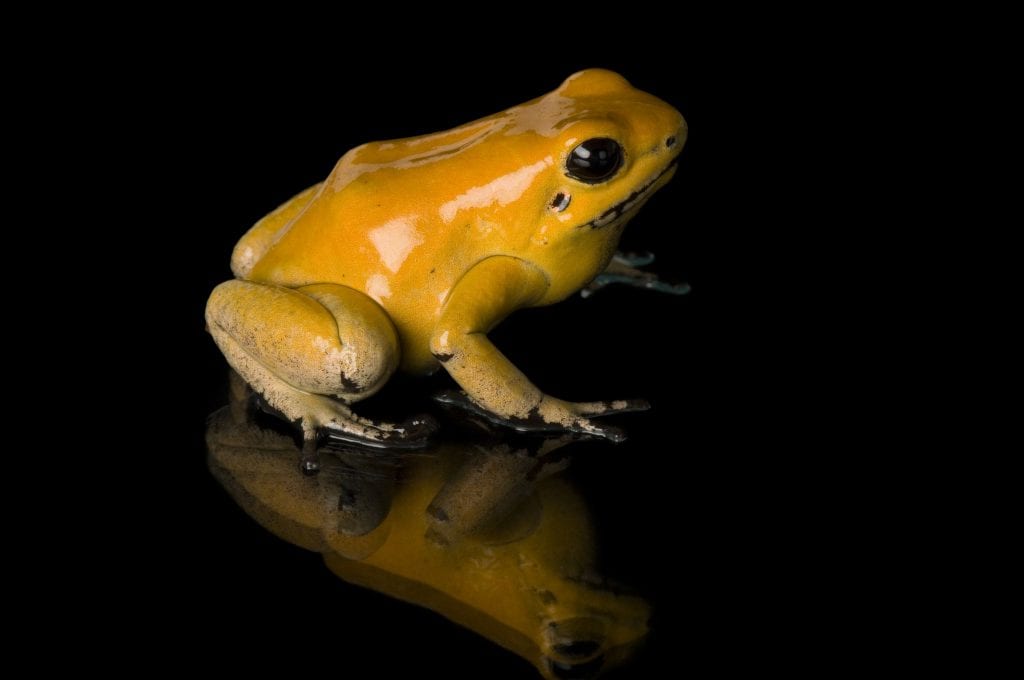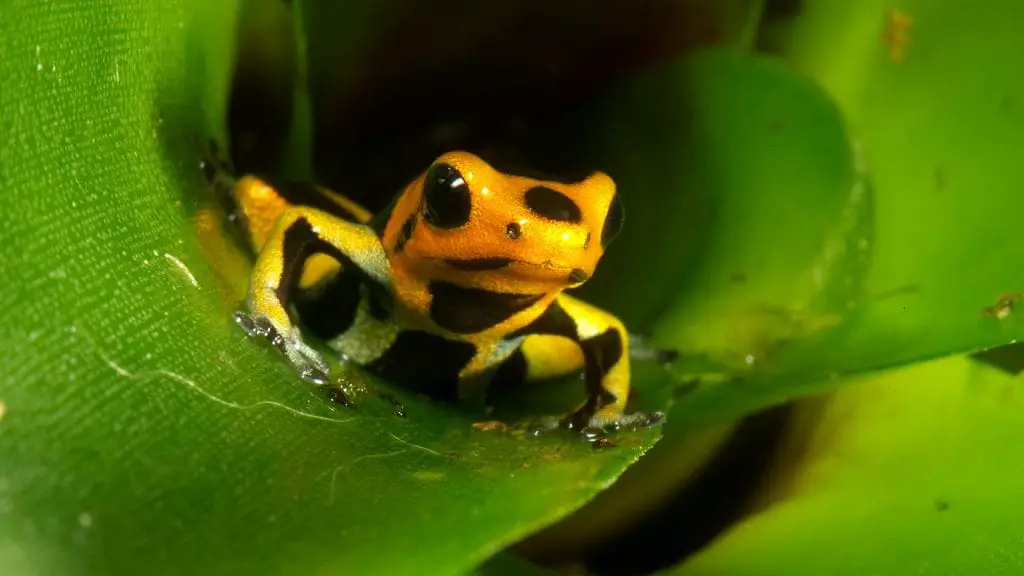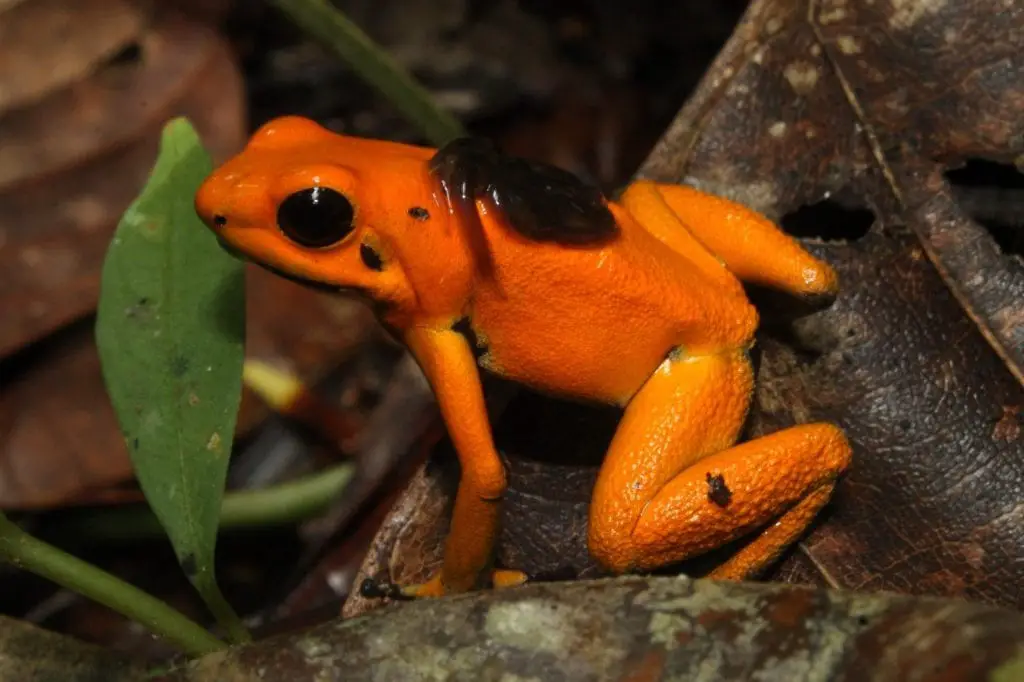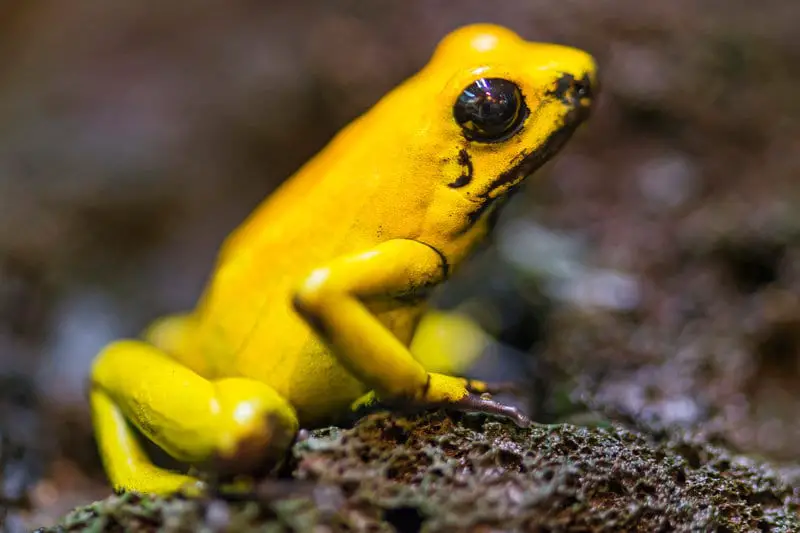Scientific Facts
| Common Name: | Golden Dart Frog, Golden Poison Frog |
| Scientific Name: | Phyllobates Terribilis |
| Length: | Up to 2 inches |
| Life Span: | 7 to 10 Years |
| Clutch Size: | 20 to 30 eggs |
| Habitat: | Lowland Rainforest |
| Country of Origin: | Colombia |
Physical Description

Golden Dart Frogs are, no doubt, the most attractive animals in the amphibian and reptile world. In fact, in almost every zoo, one dart frog exhibit can be found. Aside from being the most colorful types of dart frogs, they are also the largest. Golden Dart Frogs are the only dendrobatid frogs which are used in poisoning the darts of the indigenous tribes of Northwestern South America. Of the Dendrobatidae dart frog family, only the Golden Dart Frog possess dangerous levels of a toxin that can kill a person.
Golden Dart Frogs can be acquired in three morphs. The most common one, the mint morph, features a metallic mint green color that is generally larger than other morphs. These frogs can blend really well with green foliage. This can be taken into consideration when selecting plants and substrate to place inside your terrarium. For instance, a dead leaves carpet may make a contrasting display inside the terrarium for your mint morph.
These frogs can grow up to 2 inches in size. The size does not solely depend on length. Golden dart frogs are more powerfully built and much broader than other related subspecies. With this, they are much capable of tackling larger prey, even ignoring small prey that is usually attracted to other related species.
Aside from their marginally smaller size and slimmer build, male frogs are usually challenging to distinguish from females. They also reach maturity around 18 months of age. Mature male frogs feature slits inside their throat, with at least one of them being open so that the frog can make a significant calling sound as they inflate the vocal sac. This only happens near maturity. Mature male golden dart frogs are known to be the loudest among all dart frog species. There have also been reports of female golden dart frogs calling as a response to males. Even frogs in captivity make such as squawking sound as a response to a male finishing his long call.
Habitat and Range
This beautiful yet deadly creature lives in the lowland rain forest nearby the Pacific Coast of Colombia. The natives of the Embera tribe of the Cauca region use the secretions of Golden Dart Frogs on their blowgun darts. This species has enough toxins that wiping a dart merely along the back of a frog that is heat-stressed will already yield enough toxin that can kill a huge mammal.
Poison
Good news for hobbyists, however, because captive-bred frogs do not have these dangerous toxins, making them safe to keep inside a terrarium. The reason behind this is because the frogs gather and concentrated their fatal poisons from the food that they eat in the wild. It is not sure as to which food items help them produce poison. One guess among researchers is beetles.
It does not mean, however, that captive-bred Golden Dart Frogs do not have toxins. However, the levels of toxins that they produce on their own are most unlikely to pose a threat to the life of a healthy human adult, even when they are eaten.
Just like all other amphibians, Golden Dart Frogs should never be handled unless needed. Amphibians, in general, have permeable and delicate skin, which makes them prone to the soaps, secretions, and pollutants on human skin. Handling of these frogs should be gentle, only done with pre-rinsed hands. After handling the frogs, it is important to wash your hands thoroughly with soap and water.
Behavior
Even though the golden dart frog can be considered as the most infamous among all amphibians, it is also the hardiest and boldest dart frogs in captivity. In fact, their ease of feeding and striking appearance and ease of feeding places this species on top of the favorite list of beginners, as well as skilled enthusiasts.
These bold and large frogs are described as being highly terrestrial. Despite the fact that they love climbing at times, they are seen commonly on the floor of their terrariums, even more than other dart frog species. With this in mind, it is really important to select a terrarium which offers a huge amount of floor area for every frog.

Housing and Care
For adult frogs, it is recommended to prepare a space of 100 square inches, minimum. This will enable you to house three adults comfortably inside a 20-gallon long aquarium. Some keepers house 5 adult frogs in a 40-gallon breeder tank, with a dimension of 36 inches in length and 18 inches in width. Juvenile frogs can also be kept inside smaller tanks as they continue to grow. Five or six juveniles can also be housed inside a 5-gallon terrarium, given that it is well-maintained and monitored, and that it is just a temporary arrangement.
A good option for housing is an all-glass terrarium. This is a cheaper choice, though custom-made acrylic terrariums can also be readily purchased from specialist vendors. Big-name terrariums are also commonly sold at reptile shows and can be converted readily into terrariums for your golden dart frogs. It is very important to maintain a secure-fitting lid for your housing.
The terrarium should be able to maintain humidity. This can be done by misting daily. Distilled water is recommended for this purpose as it will not leave any mineral deposits on the glass. When this happens, your view of the frogs might be obscured. If you have more than one enclosure, or you want to create a highly attractive terrarium, you may want to invest in a commercial misting system. They may be pricey, but you can definitely save time in misting the enclosure every day. Having this system can also provide the assurance of maintaining a constant level of humidity. This is helpful whether you are around or not.
Preparation
To prepare for the setup, some keepers make a drawing of how they want the finished terrarium to look like. Constructing the background is usually the first step. The easiest way to do this is by using aquarium silicone in order to glue the tree fern fiber panels against the back wall. These panels are useful in planting climbing plants. Mosses also start to grow on the panels in just a few panels.
Another material option for the background is a layer of expanding polyurethane foam sprayed on the wall of the aquarium. When this material is cured, it is then covered with silicone, and another layer of substrate material, such as coconut fiber.
After setting up and curing the background, you can then work on the drainage layer. This is where the excess moisture will go to, rather than being drenched in the substrate. When this happens, the substrate may end up rotting, becoming anaerobic when drenched with water. In huge terrariums, a pond area can even be installed.
The drainage may be made out of a low-density material, such as LECA/hydroton. Alternative choices also include a plastic egg crate that is often sold as fluorescent lighting or diffuser. There are alternatives that are available commercially from dart frog vendors. Aquarium gravel may also be a cheaper option, though it can be somewhat weighty, which is important, especially when it comes to moving the terrarium.
Cover your drainage layer with fine fiberglass mesh, like a window screen. This will help in preventing substrate particles from entering inside the drainage layer. The substrate needs to be at least one inch in thickness. Valleys and slopes may also be constructed by creating a variation on the depth of the substrate. Your option on substrates should be free from perlite and artificial additives.
Among the favorite options include coconut husk that is combined with coconut fiber and aquatic soil products. Recently, many hobbyists also make their own substrate mixture with clay components, as this seems closer to mimicking the natural substrate that is usually found in the rain forest. Some keepers cover their substrate with leaves, which can last a long time, even under humid conditions. Among the suitable species include magnolia, oak, pin oak, sea grape, and Indian almond. Thicker leaves usually last longer.
Landscaping
The choice of enclosure landscaping is entirely up to you. If your aim is to achieve aesthetic appeal on the housing of your Golden Dart Frog, huge pieces of driftwood can certainly ensure a striking centerpiece, as with cork bark pieces that can look like tree trunks. They also serve as perfect sites for adding epiphytic plants and bromeliads.
When selecting wood, make sure to use one that can easily stand up regardless of the humidity of the conditions without frequently molding or easily rotting away. Among the perfect choices include Mopani, ghost wood, manzanita, and Malaysian driftwood. Grapewood, though commonly available in reptile terrariums, may not be a good choice as they are very prone to molds.
Most female dart frogs lay their eggs in bowers. It is usually recommended to include them in your enclosure in advance. Most dart frogs also thrive well in decors such as half-coconut shell added with a plastic Petri dish beneath. Your choice of wood may also be based on the overhangs or hides that they provide. If you use foam-base as a background, you may also carve shelves and caves for the same purpose, and then cover the foam with coconut fiber and silicone.
Note that when it comes to adding plants to your enclosure, most terrarium plants are almost partially epiphytic, which means that they usually get their nutrients from the air. This can include tank bromeliads, such as the Tillandsias and Neoregelia. When selecting one, choose those that are small enough to fit inside the terrarium.
Most options that are available at garden centers and hardware stores are large species youngsters, or ones that have been forced to bloom at small sizes. It would be best to talk with a dart frog vendor and request specific recommendations. There are few suitably sized options, which include ampulacea read, dartanion, ritzy red, June night, shamrock, ariel, and fireball.
Other tropical plants may also be planted within the layer of the substrate. Among the popular choices include tropical mosses, Hoya, Peperomia, Ficus, aroids, and tropical begonias. Aquatic plants also do well in these setups. Make sure to rinse these plants well to remove any presence of pesticide residue before putting them inside the terrarium.
For these plants to thrive successfully, you may want to add an artificial lighting solution. The most convenient solution for these setups is using fluorescent lighting fixtures that are usually available for aquariums. Selecting the freshwater variants since these bulbs are usually in their proper color temperature range, which is ideal for the growth of tropical plants.
Light and Temperature
Golden Dart Frogs are among the most heat-intolerant and cold-tolerant species of dart frogs. The appropriate daytime temperature range for them is 65 to 75 degrees Fahrenheit, which is then followed by a slight drop of nighttime temperature at 60 degrees. This species is not tolerant of temperatures that go over 80 degrees. If it is not possible for you to maintain temperatures just below this maximum, adding an air conditioner is an alternative, as well as keeping them in a basement. Other keepers add a heating solution, such as a heating cable for their terrariums.
These heating cables are generally sold for growing plants, though commercial manufacturers are starting to market them to other keepers. When selecting one, it is recommended to get a waterproof setup, along with an appropriate thermostat. These types of systems offer a near-constant, gentle heat. If you have a space for large drainage that always contains more than an inch of water, having aquarium water may be a good option. These will directly heat the water, though this may also pass on some heat to the substrate and air.
The maintenance of your terrarium every month needs to be minimal. Trim the live plants as they grow out of control and block your view. Wipe the glass using a paper towel that is dipped with distilled water. The light bulbs also lose intensity through time and are replaced best once every year.
Feeding and Diet

First-time keepers find it a challenge to keep dart frogs. The good news is that feeding them is quite easy. Almost all hobbyists culture their very own fruit flies as food for their pets. Culturing supplies are generally available from online venders as well as various reptile shows. The larger species of cultured fruit flies are the staple choice for larger dart frogs, including the golden dart frogs.
However, fruit flies are not enough to satisfy the needs of golden dart frogs. They need supplementation using commercial vitamin and mineral supplements. Some keepers dust their fruit flies at each feeding. Adult golden dart frogs need to be fed every 2 to 3 days. Froglets and youngsters need to be fed every day. Well-fed adult golden dart frogs can go an entire week without feeding. Things are different with youngsters, however. This means that if you need to go on vacation, make sure that somebody is left to tend and feed your frogs.
The lack of food variety demands the need for supplements for your golden dart frogs. This may turn out to be unavoidable when gathering a reliable and small food source for your dart frogs. Captive-cultured crickets are usually a good alternative that can add variety to the diet of your frogs. Adult frogs are can tackle almost mature crickets quite easily. Youngsters, on the other hand, love hatchling and pinhead crickets.
Some keepers make a mistake when thinking that bigger prey items and crickets are necessary in order to keep their golden dart frogs successfully. This is not the case, though. Still, there is evidence that a variety of food may further encourage breeding among these frogs. This means that introducing a variety in their diet can even be a good thing.
These frogs are well-capable of consuming bigger food items. In fact, they love some of them, including firebrats and waxworms, which prove to be a high-fat food for them. However, it is recommended to feed your frogs with waxworms only on rare occasions. Once or twice a month will do.
Breeding
If both male and female golden dart frogs are present, healthy mature frogs will usually start to breed when they reach 18 months of age. Some do not successfully breed for over two years. There is no unique stimulus for breeding that needs to be implemented since these frogs come from tropical regions, breeding naturally throughout most of the year.
The time that it usually takes to reach maturity means that they are out for a longer-term investment for any breeder. The eggs are laid inside a bower, or on the leaf of a plant. The clutches are usually large, between 20 to 30 eggs. The eggs usually hatch in 14 days. Male frogs are observed to carry the hatchlings individually or in packs to the nearest source of water. A pond inside the terrarium is good for this purpose.
Tadpoles do not usually secrete growth-inhibiting hormones. As such, they need to be kept at temperatures similar to that of adults in the day time. If caring for tadpoles out of the terrarium and using tap water, make sure to treat it with aquarium dechlorinator, administering a tannin-rich additive to mimic their natural water conditions.
The staple diet of tadpoles includes fish food pellets. Some keepers alternate the use of fish food pellet that contains vegetable matter, and the normal fish food component. Golden dart frogs develop in as little as 50 to 60 days. Make sure to prepare an easy escape from the water source to ensure that the froglets do not accidentally drown.
Where to Get a Golden Dart Frog
Golden dart frogs are available only as captive-bred pet options. In fact, it is not recommended to acquire frogs from the wild. Wild frogs are usually protected from export, which means that all of the specimens usually found in captivity in Europe and the United States have descended from either legally or illegally exported golden dart frogs.
Alberta and British Colombia in Canada have already banned the export and possession of this species as a result of the misinformation that captive golden dart frogs are toxic. In other places of North America, golden dart frogs are available readily for the dart frog hobbyists and can be secured from recognized dart frog vendors.
Mint morph golden dart frogs are among the specimens that are commonly available. They are also generally the least expensive options. Both the yellow and orange morphs are somewhat less common, and as such, a bit more expensive. When it comes to purchasing golden dart frogs, there is no need to pay over $90 for a juvenile frog.
How to Choose a Golden Dart Frog
When it comes to selecting a good golden dart frog, find one with bright eyes, well-fed belly, bold nature, and skin free from any secretion. A healthy frog is usually observed to be keen on chasing food. Young frogs are usually dark brown or black in color, with stripes of adult color noticeable from either side of the head, and along the upper edges of their back. They also have patchy or spotted legs. They usually do not develop their solid colors until they are a few months old.
FAQ Section
What will happen if you touch a Golden Dart Frog?
The poison of a Golden Dart Frog is strong enough that one frog can even kill 10 men with just a single dose. In terms of strength, it usually takes only 2 micrograms, which is an amount that easily fits on a pinhead, poisoning a single adult human.
Where did Golden Dart Frogs get their name?
Golden Dart Frogs are often called Poison Dart Frogs because Choco people from Western Colombia use their poison to coat the tips of their blow darts for hunting. In order to avoid the poison, they use waxy leaves in picking up the frogs, dipping their blow darts in the skin secretions of the frogs.
Can a Golden Dart Frog kill an elephant?
It has been said that since Golden Dart Frogs secrete batrachotoxin, which is often considered as among the most potent toxins found in nature. As such, these frogs have enough poison to actually kill an elephant.
Can you hold a Golden Dart Frog?
Handling Golden Dart Frog briefly in order to move them or cupping them for shipping is just fine. However, handling them for a long time or two can be dangerous to the health of the frogs. If there is no need to catch a Golden Dart Frog, firmly, yet loosely hold them, putting them inside a holding container.
Can you have a Golden Dart Frog as a pet?
Golden Dart Frog may be kept as frogs, just like other species of frogs. This is because of a seemingly unexplainable reason when they are cared for and bred in captivity. These frogs are not poisonous. They need to be kept inside a vivarium, one that is humid and warm.
Can Golden Dart Frogs hurt humans?
Golden Dart Frogs do not have limitations. They keep their poison in glands beneath their skin. Any reckless individual taking a bite will be immediately in trouble. Other Golden Dart Frogs are less toxic compared to others. Only a handful of species pose a risk among humans.
How does a Golden Dart Frog kill you?
A single Golden Dart Frog may contain enough poison that can kill over 20,000 mice or over 10 people. The toxin that is equal to two grains of salt is already enough to kill a person. The poison prevents the nerves from transmitting impulses permanently, leading to heart failure. There is no cure to this poison, and death can occur in less than 10 minutes after contact.
What is the deadliest frog in the world?
The Golden Dart Frog is the deadliest frog endemic to the Pacific Coast of Colombia.
Do Golden Dart Frogs need live plants?
Live plants can be added inside the vivarium. Tropical plants are good options, though it is recommended to choose plants that will not grow too large inside the terrarium.
How long do Golden Dart Frogs live?
Golden Dart Frogs live quite long, with an average life span of 7 to 10 years. There are also some reports of these frogs living much longer, depending on the care given to them.
Are Golden Dart Frogs endangered?
Many species of poison dart frogs are facing a decrease in numbers, while some have been classified as endangered because of their loss of rainforest habitat.
Where are Golden Dart Frogs located?
In nature, Golden Dart Frogs live exclusively in Colombia. In highly limited scope, they can be found in small coastal areas by the Pacific Ocean. They specifically thrive in muggy, moist, and hilly rain forest locales.



